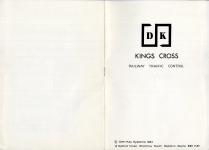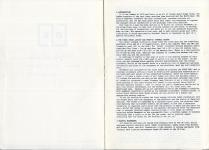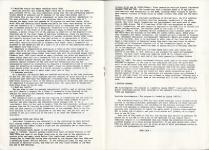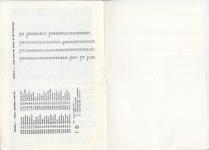

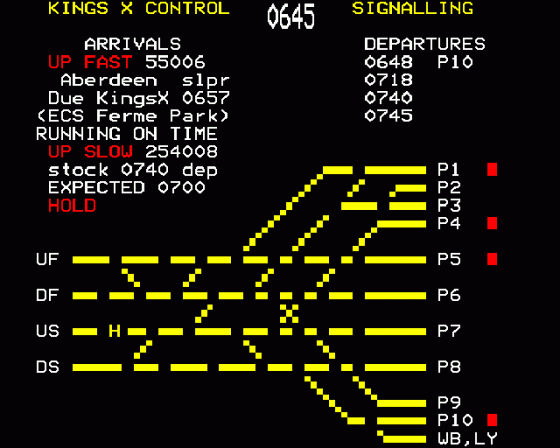

| Genre: | Game: Simulation |
| Publisher: | Deekay |
| Cover Art Language: | English |
| Machine Compatibility: | BBC Model B |
| Release: | Professionally released on Cassette |
| Available For: | BBC Model B & Spectrum 48K |
| Compatible Emulators: | BeebEm (PC (Windows)) PcBBC (PC (MS-DOS)) Model B Emulator (PC (Windows)) |
| Original Release Date: | 3rd January 1986 |
| Original Release Price: | £7.50 |
| Market Valuation: | £15.45 (How Is This Calculated?) |
| Item Weight: | 64g |
| Box Type: | Cassette Single Plastic Clear |
| Author(s): | Ashley Greenup |
Variant Items
There are 0 other items featuring this same game (that we know about!). Click any of them for their details.
Active Auctions
Closed Auctions
Buy It
Unfortunately no-one is currently selling this item.
Auction Price Watch
Worried you're being ripped off? Closing prices on eBay can help you decide what a reasonable price is for a particular item.
Full Instructions
Introduction
It is the summer of 1978 and there is an air of change about Kings Cross, the London terminus of the East Coast mainline from Scotland and the North East. The station approach trackwork has been rationalized, surburban services are electrified, and 125mph High Speed Train sets (HSTs) are beginning to replace the stalwart Deltic locomotives on the principal inter-city services.
Your task on a busy Saturday morning is to direct all traffic movements in the Kings Cross area, to deal with arriving locomotives and stock, to arrange for the fuelling of locomotives, and above all to get the scheduled departures away on time. The operation is not easy, and to make matters worse your every instruction is being monitored by Regional Control at Doncaster as part of a special efficiency study.
The Kings Cross Layout And Traffic Control System
The rather cramped terminus at Kings Cross has eight main and two subsidiary platforms (P1-8 and P9 & P10 respectively), with a bay complex (West bay WB) and locomotive yard (LY) to the side. The 'throat' trackwork through Gasworks Tunnel comprises four lines: the up and down fast (UF & DF) in the old central bore, and the up and down slow (US & DS) in the western bore. There is a hold position (H) on the up slow line, used for the transfer of locomotives between the loco yard, West bay and the platforms.
An overview of traffic in the area is given on two display screens of your control console (with the Z key used to switch from one to the other). On the first, you are informed about pending arrivals and movements over the throad trackwork, whilst on the second there is a scrolling list of departure workings and details are given of the occupancy of the platforms, West bay and locomotive yard.
Movements are initiated on the first screen by pressing the Space Bar, and in response to prompts setting a route by entering the appropriate abbreviation of the input and exit points on the simplified trackplan. There are three general rules: (1) once a route is set it will remain set until the movement occurs; (2) routes for arrivals can only be set after you have been informed that train or locomotive concerned is near Finsbury Park (failure to set a route within three minutes of this notification will result in the arrival being held at Holloway approach signals); and (3) routes for public departures can be set up up to five minutes beforehand, but the movement will not occur until the advertised time. Routes set up are indicated in red on the schematic trackplan, with segments reverting to yellow as the movement progresses. Invalid routes, or routes which conflict with those already set are denoted by a buzzer and appropriate warning caption.
To aid the setting of routes, the first screen contains coded information from the second about both the occupancy of the platforms and the status of departure workings. The former is indicated by a coloured square after the platform label (red denoting that no further traffic can be added, yellow that a departure locomotive is required, and a blank that the platform is empty and available for use), whilst the latter is given by the platform designation after the departure time (a straight platform number indicating that a train needs no further attention before despatch at the appropriate time, a platform number in brackets indicating that a train is in but not yet ready, and no platform number indicating that the stock for the working is not yet in).
Traffic Movements
All mainline arrivals are routed from Finsbury Park on the UF line, whilst surburban electric multiple units (EMUs) from Royston, empty stock from Hornsey and Bounds Green, and solo locomotives (light engines in railway parlance) from Finsbury Park traction maintenance depot all enter on the US line.
Mainline Trains And Empty Coaching Stock (ECS)
Mainline arrivals and incoming empty stock may be directed into any empty main platform (P1-8), the only constraint being that the two mid-morning parcels trains should, if possible, use P1 because of its easy road access (and to facilitate this, you may find it convenient to route the earlier 'Aberdonian' to the same platform).
On arrival in a platform there is a service time of five minutes for empty stock and upwards of 20 minutes for mainline trains, after which HSTs and coaching stock become available for their next working. At this time, the locomotive of a locomotive-hauled train is uncoupled from its stock, and it becomes possible for a departure locomotive to be attached. This should be a Class 31 if the stock is to be taken out empty to Ferme Park carriage sidings, a Deltic (Class 55) if the working is coded (D) in the departure list, otherwise any of the other types of mainline locomotive. Class 31s generally have to be transferred from the buffers of another platform, whilst other locos are normally brought from the loco yard unless it is appropriate to attach directly one of the light engines which, from time to time, return to the station area after receiving attention at Finsbury Park depot. Once a locomotive is attached to the departure end of a train, it is a rule of the simulation that it must depart with that train.
A departure is despatched by setting up a route on the track diagram to either the DP or DS line; mainline departures preferably using the DP, but empty stock workings using either line since they will be re-routed anyway after Finsbury Park. HSTs leave behind an empty platform, but after the departure of other trains there will be a locomotive left at the buffers and this must be removed before another working can enter the platform. Mainline locomotives normally require transfer to the loco yard for refuelling, but you may occasionally receive an instruction to despatch a locomotive on one of the down lines for attention at Finsbury Park depot. Class 31s which brought in empty stock should either be moved to a return working in another platform or be stabled in the loco yard to await their next turn of duty.
Surburban Services
On a Saturday, the Royston EMUs are handled exclusively in the side platforms P9 and P10. The basic outer surburban service consists of units arriving at 6 and 36 minutes past each hour for departure 12 minutes later, with additional semi-fasts joining in later in the morning arriving at 20 minutes past each hour for departure 8 minutes past the following hour. All units must be despatched from Kings Cross on the DS line.
West Bay Traffic
The bay area is used for parcels and motorail traffic, and at various times you will receive a request for a Class 31 locomotive to be directed to the complex for shunting and eventual working of empty stock to Ferme Park.
Locomotive Yard
The locomotive yard is used for the stabling of locomotives and the fuelling and service of recent mainline arrivals. The latter takes between 45 and 75 minutes, and, when complete, the indicated status changes from 'f' to 'a' (available). Entry to the yard is usually from the hold position, although light engines from the US line may be signalled directly in, provided that in each case the yard capacity of eight locomotives is not exceeded. Exit is via the hold position to one of the platforms or the West bay, and you will only be allowed to set up a route out of the yard if at least one locomotive is available.
Locomotive Types And Their Use
Individual locomotives are referred to in the simulation by their British Rail running numbers, which are a coded classification with the last three digits giving the number within a class and the preceeding two or three digits the class designation.
The following types appear in the simulation:
Class 31 (1470hp). General purpose locomotives built by Brush Traction in the late 1950s and used in the Kings Cross area at the time of the simulation on station pilot and empty stock duties (the traditional workings of the locomotives to Cambridge having been replaced by the Royston semi-fast EMUs and a connecting diesel shuttle service). In the simulation Class 31s must not be allocated to mainline trains, and they are the only class allowed in the West bay and on ECS workings.
Classes 40, 45 and 46 (2000-2500hp). First generation mainline diesels introduced between 1958 and 1963. The locomotives have a maximum speed of 90mph and as such were not used extensively on the BCML, although Peaks (Classes 45 and 46) were regular visitors to Kings Cross on summer reliefs from Leeds and the North East.
Class 47 (2580hp). The vertiable workhorses of British Rail, the 47/4 subclass (47401-601) being the principal mainline passenger locomotives of the whole system. The first twenty locomotives are non-standard, and spent much of their time on ECML duties. The 47/0 subclass (47001-298) are designated as mixed traffic locomotives, and were generally employed on the ECML only on reliefs and summer holiday workings. The maximum speed of the class is 95mph.
Class 55 (3300hp). The legendary Deltic locomotives were allocated to Finsbury Park, Gateshead (Newcastle) and Haymarket (Edinburgh) depots and seldom strayed far from the ECML. Soon to be displaced by HSTs, some of the class had, by 1978, begun a long sojourn in Doncaster works, from which they were never to return, although out of enthusiast interest all of the locomotives appear in the simulation. Every effort should be made to assign Deltics to workings labelled (D) in the departure list.
Class 254 (4500hp). Inter-City 125 High Speed Train sets just coming into service on the ECML in 1978. Setting a new standard for speed and passenger comfort, the East Coast formations comprise eight Mk III coaches with a streamlined power car at each end of the train powered by a Paxman Valenta engine.
Class 312 (EMU). The newly introduced electric stock used on the outer surburban services to Royston. At the time of the simulation, the final two units were still to be delivered from York and the sets were running with their original numbers prior to having 700 added to distinguish them from the inner surburban Class 313 units in the restricted Great Northern line train reporting system. Based at Hornsey, the units are noted for their smooth acceleration up to a maximum speed of 90mph. In the simulation all surburban trains, use platforms 9 and 10, and only Class 312 units are allowed in these platforms. Although only a single set number is given, some of the workings will in fact comprise multiple sets.
Getting Started
BBC:
CHAIN"" (RETURN)
Users with disc or Econet interfaces must first return to the cassette filing system by typing *TAPE and PAGE=&E00).
Spectrum:
LOAD"" (ENTER)
The simulation starts at 0645 hrs with three overnight trains already having arrived in the main platforms; passengers are still vacating the Night Capitals and Night Scotsman sleepers, but unloading of the previous evenings 1930 hrs service from Aberdeen is complete and a Class 31 locomotive is attached and awaiting your instructions to remove the empty stock. A Royston outer-surburban EMU is almost due to depart, and your first action will probably be to signal this to the DS line.
Your turn of duty ends at 1345 hrs, but you may quit earlier by pressing the ESCAPE key on the BBC or the Q key on the Spectrum (if you require only a temporary respite it is recommended that you freeze the simulation on either the platform display or a route setting directive). If you have worked until after 0900 hrs before quitting you will be given an end of shift performance rating on a scale from outstanding to disastrous.
Good luck!
Appendix 1: Public Departure Workings
| 0648 | (E) | Royston | 1055 | (D) | Edinburgh | |
| 0718 | (E) | Royston | 1108 | (E) | Royston | |
| 0740 | (H) | Newcastle | 1112 | (L) | Scarborough | |
| 0745 | (D) | Bradford | 1118 | (E) | Royston | |
| 0748 | (E) | Royston | 1135 | (H) | Newcastle | |
| 0800 | (H) | Edinburgh | 1148 | (E) | Royston | |
| 0804 | (L) | Hull | 1155 | (D) | Aberdeen | |
| 0818 | (E) | Royston | 1204 | (L) | Hull | |
| 0848 | (E) | Royston | 1208 | (E) | Royston | |
| 0900 | (D) | Edinburgh | 1218 | (E) | Royston | |
| 0904 | (D) | Leeds | 1235 | (R) | Leeds | |
| 0908 | (E) | Royston | 1245 | (D) | Bradford | |
| 0912 | (L) | Skegness | 1248 | (E) | Royston | |
| 0918 | (E) | Royston | 1300 | (D) | Edinburgh | |
| 0930 | (L) | Edinburgh | 1304 | (L) | Cleethorpes | |
| 0948 | (E) | Royston | 1308 | (E) | Royston | |
| 1000 | (H) | Edinburgh | 1318 | (E) | Royston | |
| 1004 | (D) | York | 1325 | (D) | Newcastle | |
| 1008 | (E) | Royston | 1348 | (E) | Royston | |
| 1012 | (R) | Edinburgh | 1400 | (H) | Edinburgh | |
| 1018 | (E) | Royston | 1404 | (L) | York | |
| 1045 | (D) | Harrogate | 1408 | (E) | Royston | |
| 1048 | (E) | Royston | 1412 | (R) | Edinburgh | |
| 1050 | (L) | Newcastle | 1418 | (E) | Royston |
The train codes are:
E : EMU
H : HST
D : Deltic hauled
L : Loco-hauled (scheduled)
R : Loco-hauled (relief)
Appendix 2: Locos Which May Appear In The Simulation
| 31183 | 47036 | 47518 | 55020 |
| 184 | 170 | 519 | 021 |
| 185 | 219 | 520 | 022 |
| 186 | 272 | 521 | |
| 187 | 401 | 522 | 254001 |
| 188 | 402 | 523 | 002 |
| 189 | 403 | 524 | 003 |
| 190 | 404 | 525 | 004 |
| 191 | 405 | 526 | 005 |
| 192 | 406 | 527 | 006 |
| 217 | 407 | 528 | 007 |
| 218 | 408 | 541 | 008 |
| 219 | 409 | 542 | 009 |
| 220 | 410 | 543 | 010 |
| 221 | 411 | 544 | 011 |
| 222 | 412 | 545 | 012 |
| 223 | 413 | 546 | |
| 224 | 414 | 547 | 312001 |
| 225 | 415 | 548 | 002 |
| 226 | 416 | 549 | 003 |
| 401 | 417 | 550 | 004 |
| 402 | 418 | 551 | 005 |
| 403 | 419 | 552 | 006 |
| 404 | 420 | 553 | 007 |
| 405 | 421 | 008 | |
| 406 | 422 | 55001 | 009 |
| 407 | 423 | 002 | 010 |
| 408 | 424 | 003 | 011 |
| 425 | 004 | 012 | |
| 40060 | 426 | 005 | 013 |
| 078 | 427 | 006 | 014 |
| 086 | 428 | 007 | 015 |
| 145 | 429 | 008 | 016 |
| 157 | 430 | 009 | 017 |
| 431 | 010 | 018 | |
| 45016 | 432 | 011 | 019 |
| 038 | 433 | 012 | 020 |
| 124 | 434 | 013 | 021 |
| 435 | 014 | 022 | |
| 46027 | 465 | 015 | 023 |
| 035 | 471 | 016 | 024 |
| 041 | 493 | 017 | |
| 046 | 516 | 018 | |
| 055 | 517 | 019 |
Screen Designers
The following utilities are also available to allow you to edit the supplied screens of this game:
Cheats
Download
A digital version of this item can be downloaded right here at Everygamegoing (All our downloads are in .zip format).
| Download | What It Contains |
|---|---|
| A digital version of RTC Kings Cross suitable for BeebEm (PC (Windows)), PcBBC (PC (MS-DOS)), Model B Emulator (PC (Windows)) |
Report A Problem
We thank you from the bottom of our hearts if you report something wrong on our site. It's the only way we can fix any problems!
You are not currently logged in so your report will be anonymous.
Add Note
Release Country
Change the country to update it. Click outside of this pop-up to cancel.
Scan Of Selected Article
If you auction an item, it will no longer show in the regular shop section of the site.






